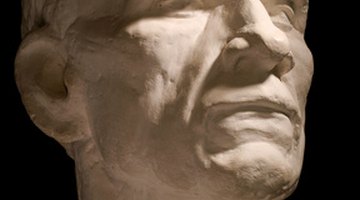How to Mold and Cast a Face
Whether you find it cool, creepy or weird, making a plaster cast of a face is an inexpensive art project. Making a mold of a face requires the help of someone who doesn't mind sitting still for 45 minutes or more. It is best to enlist the help of several friends, as the materials used dry quickly.

Things You Will Need
- Dropcloth
- Large measuring cup
- Buckets
- Metal whisk
- Shallow cardboard box
- Towel
- Alginate
- Plaster
- Water
- Cheesecloth
- Petroleum jelly
- Drinking straws
Making the Mold
-
Cover the work area with a dropcloth. Ensure the person whose face is to be cast is wearing old clothing that you can discard if it becomes ruined.
-
Cut the cheesecloth into strips 1 to 2 inches wide and 3 to 4 inches long. Cut some smaller pieces as well to use around the nostrils.
-
Rub a small amount of petroleum jelly over the eyebrows and eyelashes, and around the perimeter of the face of the person to be cast to prevent pulling out hair when you remove the mask.
-
Mix the alginate in a bucket according to package directions.
-
Cover the face with alginate. Work it as close to the hairline as possible. Work carefully around the nose to avoid interfering with breathing. If this becomes an issue, cut short pieces of drinking straw and insert them into the nostrils to keep them clear. Work quickly, as the alginate will dry in just a few minutes.
-
Mix a bucket of plaster according to package directions. Dip each strip of cheesecloth into the plaster; squeeze out any excess plaster; and place them over the alginate. Continue until the entire face is covered.
-
Allow the plaster to dry completely. Depending in factors like elevation and humidity, this will take about 20 to 30 minutes. Loosen the edges of the alginate with your fingers, and the mold should come off.
-
Use several more small strips of plaster-covered cheesecloth to cover the nostril holes from the outside of the mold.
-
Mix a small amount of alginate and use it to patch the nostril holes from the inside of the mold.
Casting the Face
-
Line a shallow cardboard box with a towel. Use the towel to stabilize the mold in a level position, laying face-down in the towel. Place the box on a stable surface.
-
Pour plaster into the mold until it is completely filled. Pour slowly to avoid creating air bubbles in the plaster.
-
Allow the plaster to dry for 30 to 45 minutes, until it is completely cured and firm.
Tip
Alginate is used in dental work for making casts for teeth. Try casting the mold in latex instead of plaster to create a custom mask.
Warning
Take great care when using straws to help the model breathe. Ed McCormick of EnvironMolds notes that there is a risk of pushing the straws further up into the nostrils, which would harm the model. McCormick suggests covering the nose last and using cotton swabs to wipe away material at the nostrils.
Wear old clothes during this project, as the process is very sloppy.
References
Tips
- Alginate is used in dental work for making casts for teeth.
- Try casting the mold in latex instead of plaster to create a custom mask.
Warnings
- Take great care when using straws to help the model breathe. Ed McCormick of EnvironMolds notes that there is a risk of pushing the straws further up into the nostrils, which would harm the model. McCormick suggests covering the nose last and using cotton swabs to wipe away material at the nostrils.
- Wear old clothes during this project, as the process is very sloppy.
Photo Credits
- Plaster head image by Supertrooper from Fotolia.com
- Plaster head image by Supertrooper from Fotolia.com
More Articles


